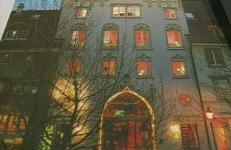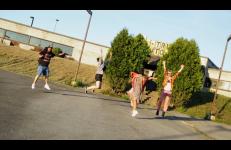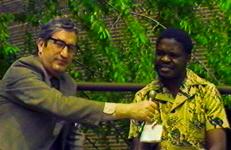This two-part episode features Glenn Belverio and Duncan Elliott participating in an ACT UP demonstration at President George Bush’s summer house in Kennebunkport, Maine, interviewing activists and documenting this historic event. In addition to this, Brenda Sexual and Glennda Orgasm attend Wigstock, an annual outdoor drag festival in Manhattan's East Village. At the festival, they rally for National Healthcare and discuss other issues such as violence against LGBTQ+ people.
Politics
This two-part episode features Glenn Belverio and Duncan Elliott participating in an ACT UP demonstration at President George Bush’s summer house in Kennebunkport, Maine, interviewing activists and documenting this historic event. In addition to this, Brenda Sexual and Glennda Orgasm attend Wigstock, an annual outdoor drag festival in Manhattan's East Village. At the festival, they rally for National Healthcare and discuss other issues such as violence against LGBTQ+ people.
Water and paths of migration converge to shape the borderlands along the U.S./Mexico boundary when staging actors in a politicized landscape leads to the rupture of fiction for fact.
terrestrial sea was co-created with Luc Houle.
"Shaharazad is trapped at the Baghdad Hilton, so she conjures up an ironic story of the great King Bush's attempt at 'protecting one dictatorship from the attacks of another'" - Scott Andrew Hutchins
"Shaharazad is trapped at the Baghdad Hilton, so she conjures up an ironic story of the great King Bush's attempt at 'protecting one dictatorship from the attacks of another'" - Scott Andrew Hutchins
In this video, Brenda and Glennda attend the opening day of The New Festival (now known as NewFest), a queer film festival in New York City. They interview attendees and filmmakers at the festival to discuss the importance of queer film. Videographer Hans Christian Dany pans back and forth between Brenda and Glennda's interviews and onlookers of the festival, some of whom seem intrigued by the crowd gathering outside the theater, and some who seem offended by the openly queer festival goers.
In this episode of The Glennda and Brenda Show, Glennda and Brenda take over a public bus to protest discrimination and violence against queer people who are "out and outrageous". They pick up many other out and proud friends to stage this queer sit-in.
Interspersed with clips of Judy Garland films and televised concerts, Glennda Orgasm and Judy LaBruce (Bruce LaBruce's Garland inspired drag persona) travel to the West Village to "discover their gay roots". They discuss the current state of queer culture with people attending gay bars and patroning queer businesses, with a cameo from Sadie Benning. They discuss the idea of the post-queer movement, and give guests a "post-queer quiz".
An episode of Glennda and Friends, hosted by Glennda Orgasm and Judy LaBruce.
The Sun Quartet is a solar composition in four movements, a political composition in four natural elements, an audiovisual composition in four bodily mutations: a sun stone where youth blooms in protest, a river overflowing the streets, the burning plain rising in the city. And, finally, the clamor of the people that shook Mexico after the night of September 26, 2014. The disappearance of 43 students from Ayotzinapa opened a breach in the Mexican political body.
The Sun Quartet is a solar composition in four movements, a political composition in four natural elements, an audiovisual composition in four bodily mutations: a sun stone where youth blooms in protest, a river overflowing the streets, the burning plain rising in the city. And, finally, the clamor of the people that shook Mexico after the night of September 26, 2014. The disappearance of 43 students from Ayotzinapa opened a breach in the Mexican political body.
The Sun Quartet is a solar composition in four movements, a political composition in four natural elements, an audiovisual composition in four bodily mutations: a sun stone where youth blooms in protest, a river overflowing the streets, the burning plain rising in the city. And, finally, the clamor of the people that shook Mexico after the night of September 26, 2014. The disappearance of 43 students from Ayotzinapa opened a breach in the Mexican political body.
The Sun Quartet is a solar composition in four movements, a political composition in four natural elements, an audiovisual composition in four bodily mutations: a sun stone where youth blooms in protest, a river overflowing the streets, the burning plain rising in the city. And, finally, the clamor of the people that shook Mexico after the night of September 26, 2014. The disappearance of 43 students from Ayotzinapa opened a breach in the Mexican political body.
"In The Very Very End, Barber points to his medium's plastic possibility by somehow traveling into the future and the past, nodding to Neville Shute's apocalyptic 1957 novel On The Beach, while setting an end-of-days story in a 21st Century holiday resort.
As a foulness shall ye know Them. Their hand is at your throats, yet ye see Them not; and Their habitation is even one with your guarded threshold. The wind gibbers with Their voices, and the earth mutters with Their consciousness. They bend the forest and crush the city, yet may not forest or city behold the hand that smites. The ice desert of the South and the sunken isles of Ocean hold stones whereon Their seal is engraven. They walk unseen. They Live.
As a foulness shall ye know Them. Their hand is at your throats, yet ye see Them not; and Their habitation is even one with your guarded threshold. The wind gibbers with Their voices, and the earth mutters with Their consciousness. They bend the forest and crush the city, yet may not forest or city behold the hand that smites. The ice desert of the South and the sunken isles of Ocean hold stones whereon Their seal is engraven. They walk unseen. They Live.
As a foulness shall ye know Them. Their hand is at your throats, yet ye see Them not; and Their habitation is even one with your guarded threshold. The wind gibbers with Their voices, and the earth mutters with Their consciousness. They bend the forest and crush the city, yet may not forest or city behold the hand that smites. The ice desert of the South and the sunken isles of Ocean hold stones whereon Their seal is engraven. They walk unseen. They Live.
In 2011 as the Congress debated the budget, Ligorano Reese installed an ice sculpture of the words Middle Class in the garden of Jim Kempner Fine Art. They filmed this timelapse of the sculpture disappearing using Senator Bernie Sanders' filibuster against the Bush tax cuts as a soundtrack with music by Michael Galasso. Senator Sanders featured it on his Senate homepage.
Ice Sculpture by Okamoto Studio.
As the camera looks out through a barred window and the clock strikes four in a Swiss city, the death of Yasser Arafat provides the starting point for a journey back in time.
Throwing Stones is the third episode in the Hotel Diaries series, a collection of video recordings made in the world’s hotel rooms, which relate personal experiences and reflections to contemporary conflicts in the Middle East.
While on tour for his new book Exo-Psychology: A Manual on The Use of the Nervous System According to the Instructions of the Manufacturer, Timothy Leary gives a lecture at the University of Illinois Circle Campus (now University of Illinois Chicago). At the start, Leary draws parallels from various cultures from human history and asserts that those who migrated and moved beyond their known environments, the restless and the visionaries, are the ones who advanced human civilization.
This film is the result of an intimate time spent between the filmmaker, who lives today in Belgium, and his father who is a former political prisoner. It looks at the complex political system of Egypt under Nasser.
This title is only available on Radical Closure.
Tour Without End is an experimental hybrid feature-length video work that casts real-life musicians, artists, and actors as fictional bands on tour; the piece evolves into a cross-generational commentary on contemporary culture and politics in the Trump era. Shot over the course of four years between 2014-18 at over 15 DIY music spaces in and around NYC, Tour Without End functions as a time capsule — made more apparent by the shuttering of many of its locations due to NYC’s rapid gentrification.
The work’s multitude of characters are legendary performers in the downtown NYC arts scene, including: The Wooster Group founder Kate Valk, Jim Fletcher (New York City Players), Lizzi Bougatsos (Gang Gang Dance), Kathleen Hanna (The Julie Ruin), Brontez Purnell (The Younger Lovers), Eileen Myles, Alexandra Drewchin (Eartheater), Nicole Eisenman, K8 Hardy, Johanna Fateman (Le Tigre) Shannon Funchess (Light Asylum), JD Samson (MEN), Gary Indiana, Kembra Pfahler (Voluptuous Horror of Karen Black), Rachel Mason, Tom McGrath, Matthew Asti (MGMT), Becca Blackwell, Christen Clifford, Alessandra Genovese (Crush), Rogelio Ramos (Love Pig), Kenya Robinson (Cheeky LaShae), and Neon Music (Youth Quake).
Addressing the imbalance of information flow between the wealthy and the destitute nations of the world, Towards A New World Information Order suggests means by which this imbalance might be rectified, including ways to control the press.
The planting of the "cempasuchil" for the celebrations of the "Day of Death" is one of the last jobs that the Ayotzianapa normal students did before they were brutally disappeared, with small Lomokino 35mm cameras, which we had to compose-hit several times since they are manufactured to be disposable, we record the harvest of the season, with the purpose of impregnating in the fragility of the chemical canvas: the earth, no longer that of the common graves but that other earth that gives light to the work of our fellow Normalistas.



























